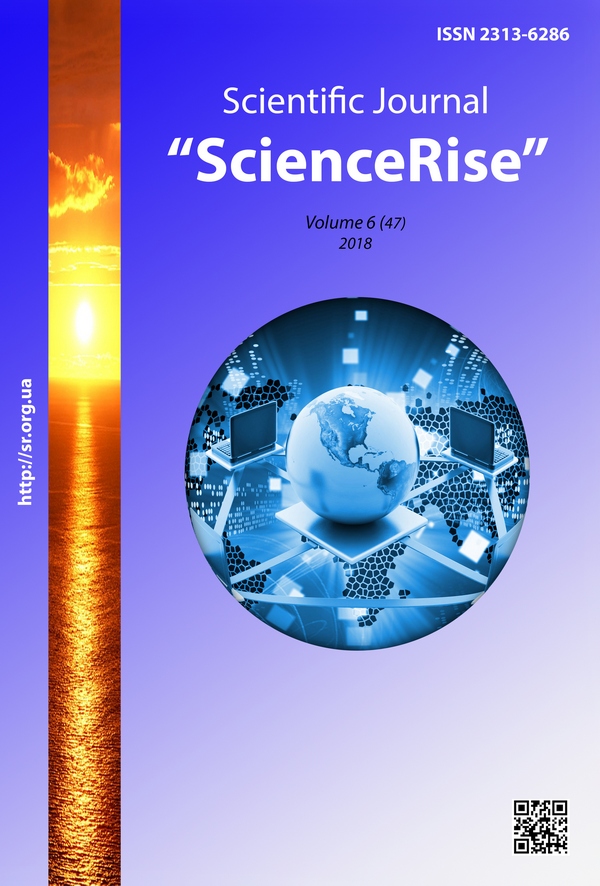Features of the precession of the two-frequency pendulum
DOI:
https://doi.org/10.15587/2313-8416.2018.134334Keywords:
water molecule, precession, two-frequency pendulum, anisotropy, oscillation type, inhomogeneous field of forcesAbstract
An analysis of the precession of the rotational oscillations of water molecules is made using the model of a two-frequency pendulum in the entire range of its oscillations. It is found that the precession of a two-frequency pendulum in the field of inhomogeneous interaction forces is anisotropic. The largest anisotropy is observed at the critical point of the change in the type of oscillations from the two-frequency one to the single-frequency one. The manifestation of precession singularities (phase changes) in the region of two-frequency oscillations, observed for cases of small initial velocities of pendulum oscillations, is considered
References
Eisenberg, D., Kauzmann, W. (1975). The structure and properties of water. Leningrad: Gidrometeoizdat, 280.
Antonchenko, V. Ya., Davydov, А. S., Iliin, V. V. (1991). Оsnovy fizyky vody. Kyiv: Naukova dumka, 672.
Bersuker, I. B. (1987). The Jahn-Teller Effect and Vibronic Interactions in Modern Chemistry. Moscow: Nauka, 344.
Malafayev, N. T. (2011). O vzaimodeystviyakh i dinamike molekul v chistoy vode [About the interactions and dynamics of molecules in clean water]. Eastern-European Journal of Enterprise Technologies, 4 (8 (52)), 48–58. Available at: http://journals.uran.ua/eejet/article/view/1465/1363
Malafayev, N. T., Pogozhikh, N. I. (2015). Features rotational of vibrations of water molecules. Eastern-European Journal of Enterprise Technologies, 2 (5 (74)), 27–35. doi: http://doi.org/10.15587/1729-4061.2015.40569
Krylov, A. N. (1954). Lekcii po priblizhennym vychisleniyam [Lectures on approximate calculations]. Moscow: Gostehizdat, 400.
Zel’dovich, B. Y., Soileau, M. J. (2004). Bi-frequency pendulum on a rotary platform: modeling various optical phenomena. Uspekhi Fizicheskih Nauk, 174 (12), 1337–1354. doi: http://doi.org/10.3367/ufnr.0174.200412e.1337
Viet, L. D., Nghi, N. B. (2014). On a nonlinear single-mass two-frequency pendulum tuned mass damper to reduce horizontal vibration. Engineering Structures, 81, 175–180. doi: http://doi.org/10.1016/j.engstruct.2014.09.038
Neistadt, А. I. (2005). Capture in resonance and scattering by resonances in two-frequency systems. Trudy matematicheskogo instituta, 250, 198–218.
Malenkov, G. G. (2006). Struktura i dinamika zhidkoi vody [Structure and dynamics of liquid water]. Journal structural chemistry, 47, 5–35.
Miceli, G., de Gironcoli, S., Pasquarello, A. (2015). Isobaric first-principles molecular dynamics of liquid water with nonlocal van der Waals interactions. The Journal of Chemical Physics, 142 (3), 034501. doi: http://doi.org/10.1063/1.4905333
Malenkov, G. G., Naberukhin, Y. I., Voloshin, V. P. (2012). Collective effects in molecular motions in liquids. Russian Journal of Physical Chemistry A, 86 (9), 1378–1384. doi: http://doi.org/10.1134/s003602441209004x
Malafayev, N. T. (2016). Rotational oscillations of water molecules as oscillations of a spherical pendulum in an inhomogeneous field of forces. ScienceRise, 2 (2 (19)), 62–69. doi: http://doi.org/10.15587/2313-8416.2016.60587
Malafayev, N. T. (2018). Analysis of phase diagrams of the two-frequency pendulum as models of rotational vibrations of water molecules. ScienceRise, 1 (42), 50–56. doi: http://doi.org/10.15587/2313-8416.2018.121426
Downloads
Published
Issue
Section
License
Copyright (c) 2018 Nikolay Malafayev

This work is licensed under a Creative Commons Attribution 4.0 International License.
Our journal abides by the Creative Commons CC BY copyright rights and permissions for open access journals.
Authors, who are published in this journal, agree to the following conditions:
1. The authors reserve the right to authorship of the work and pass the first publication right of this work to the journal under the terms of a Creative Commons CC BY, which allows others to freely distribute the published research with the obligatory reference to the authors of the original work and the first publication of the work in this journal.
2. The authors have the right to conclude separate supplement agreements that relate to non-exclusive work distribution in the form in which it has been published by the journal (for example, to upload the work to the online storage of the journal or publish it as part of a monograph), provided that the reference to the first publication of the work in this journal is included.

